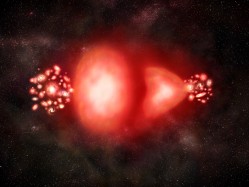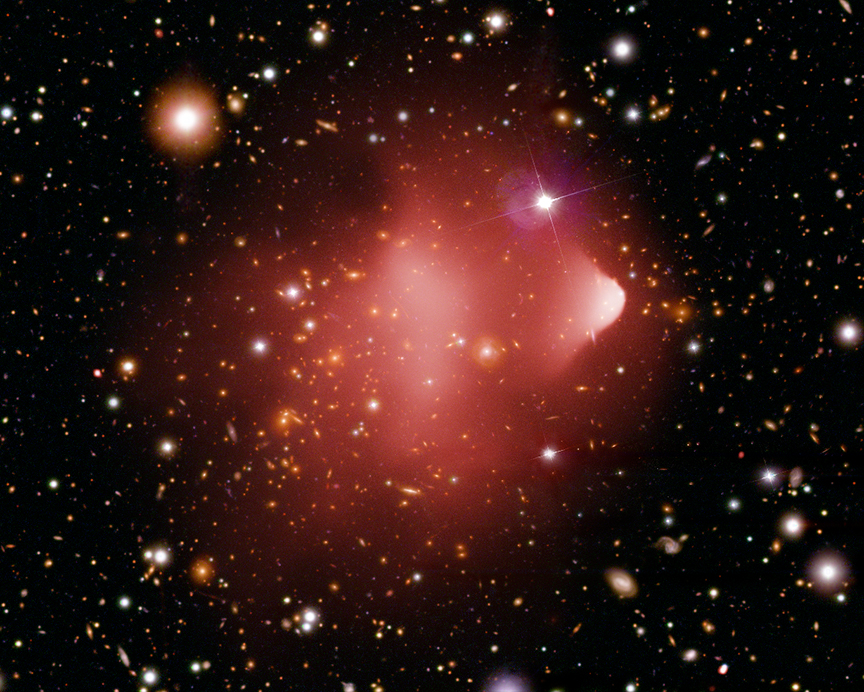[/caption]
Say the word “antimatter” and immediately people think of science fiction – anti-universes, fuel for the Enterprise’s warp-speed engines and so forth. But Captain, we can’t change the laws of physics; antimatter is the real deal. Antimatter is made up of elementary particles, each of which has the same mass as their corresponding matter counterparts –protons, neutrons and electrons — but the opposite charges and magnetic properties. When matter and antimatter particles collide, they annihilate each other and produce energy according to Einstein’s famous equation, E=mc2. But antimatter isn’t something that’s available on every corner drugstore (and neither is plutonium, to continue with the movie theme) and there’s not very much of it around, so it seems. But, according to theory, it wasn’t always that way, and scientists are using the Chandra X-ray Observatory to hunt for evidence of antimatter that was present in the very early universe. And it’s not an easy job…
According to the Big Bang model, the Universe was awash in particles of both matter and antimatter shortly after the Big Bang. Most of this material annihilated, but because there was slightly more matter than antimatter – less than one part per billion – only matter was left behind, at least in the local Universe.
Trace amounts of antimatter are believed to be produced by powerful phenomena such as relativistic jets powered by black holes and pulsars, but no evidence has yet been found for antimatter remaining from the infant Universe.
How could any primordial antimatter have survived? Just after the Big Bang there was believed to be an extraordinary period, called inflation, when the Universe expanded exponentially in just a fraction of a second.
“If clumps of matter and antimatter existed next to each other before inflation, they may now be separated by more than the scale of the observable Universe, so we would never see them meet,” said Gary Steigman of The Ohio State University, who conducted the study. “But, they might be separated on smaller scales, such as those of superclusters or clusters, which is a much more interesting possibility.”

In that case, collisions between two galaxy clusters, the largest gravitationally-bound structures in the Universe, might show evidence for antimatter. X-ray emission shows how much hot gas is involved in such a collision. If some of the gas from either cluster has particles of antimatter, then there will be annihilation and the X-rays will be accompanied by gamma rays.
Steigman used data obtained by Chandra and now de-orbited Compton Gamma Ray Observatory to study the Bullet Cluster, where two large clusters of galaxies have crashed into one another at extremely high velocities. At a relatively close distance and with a favorable side-on orientation as viewed from Earth, the Bullet Cluster provides an excellent test site to search for the signal for antimatter.
Check out this very nifty animation of galaxy clusters crashing into each other.
“This is the largest scale over which this test for antimatter has ever been done,” said Steigman, whose paper was published in the Journal of Cosmology and Astroparticle Physics. “I’m looking to see if there could be any clusters of galaxies which are made of large amounts of antimatter.”
The observed amount of X-rays from Chandra and the non-detection of gamma rays from the Compton data show that the antimatter fraction in the Bullet Cluster is less than three parts per million. Moreover, simulations of the Bullet Cluster merger show that these results rule out any significant amounts of antimatter over scales of about 65 million light years, an estimate of the original separation of the two colliding clusters.
“The collision of matter and antimatter is the most efficient process for generating energy in the Universe, but it just may not happen on very large scales,” said Steigman. “But, I’m not giving up yet as I’m planning to look at other colliding galaxy clusters that have recently been discovered.”
Finding antimatter in the Universe might tell scientists about how long the period of inflation lasted. “Success in this experiment, although a long shot, would teach us a lot about the earliest stages of the Universe,” said Steigman.
Tighter constraints have been placed by Steigman on the presence of antimatter on smaller scales by looking at single galaxy clusters that do not involve such large, recent collisions.
Source: Chandra/Harvard


Kudos on search. Antimatter can be used for propulsion purposes. This is a quest which will lead to advances.
Oooh, another article filled with facts and backed up by animations!!!
Personally, I look forward to continuing searches of such interacting galaxy clusters like MACS J0025.4-1222, Abell 520, Abell 1201 and others within range so that detailed Xray-optical-IR observations can be made to decipher this intriguing question. I hope other suitable candidate clusters are now being observed or are planned to be surveyed !
I thought the Enterprise was powered by dilithium crystals.
Okay I found this:
“Dilithium is one substance that can safely combine matter and anti-matter into a stable stream.
The Crystal becomes the focal point where the matter/anti-matter injectors fire. The crystals then combine and refract the beam in to the Warp Core. Kinda like the reverse of a light prism. Instead of only one beam of light hitting the prism and refracting into mutiple beams of light.. it does the exact opposite. Takes 2 beams of in-compatable energy, combines them to make a single stable beam of energy and fires into the warp core chamber… and voila, you have warp power!!”
So what keeps the antimatter from blowing up the dilithium?
Geordi reversed the polarity, it usually keeps it from blowing it up
most anti matter went into anti time it should be out there about 28 billion light yrs away…….i can almost feel it
RetardedFishFrog-
I think it was the matter/antimatter inducer.
Nancy
It wasn’t the tachyon impulse modifier?
Isn’t there antimatter in MRI systems? (positrons)
Dark Gnat, you’re thinking of PET. Substances that decay by positron emission are injected and allowed to circulate. The positrons annihilate with electrons in the body, which emits gamma rays traveling in opposite directions that get detected.